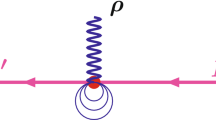Abstract
Let me begin with a brief summary of the present status of weak interaction theory. The basic interaction is described in terms of charged currents
where J is the hadronic current assumed to be of the Cabibbo form
where the superscripts define components of an SU3 octet. Here we will be interested only in the strangeness-conserving current cosθ(Jλ 1 + iJλ 2) where 1,2 are isospin indices. Beyond the assumed isovector property we desire to specify the hadronic current as com-pletely as possible. This is much harder than in the case of the leptonic current (the first two terms of Eq.(2)) because we do not know what elementary particles to use to describe the current. A standard assumption is that this current has the basic properties described by the quark representation
where p,n are the field operators of the quarks. Unfortunately, this leads to very few conclusions without a knowledge of the strong interactions of quarks.
Access this chapter
Tax calculation will be finalised at checkout
Purchases are for personal use only
Preview
Unable to display preview. Download preview PDF.
Similar content being viewed by others
References
No attempt is made here at a comprehensive bibliography. Details and references concerning most of this paper may be found in T. D. Lee and C. S. Wu, Ann. Rev. Nuc. Sci. 15, 381 (1965).
S. Weinberg, Phys. Rev. 112, 1375 (1958).
For a detailed review see R. J. Blinstoyle, Proceedings, Topical Conference on Weak Interactions, p. 495 (CERN, 1969 ). For a discussion of radiative correction uncertainties see E. S. Abers, D. A. Dicus, R. E. Norton, and H. R. Quinn, Phys. Rev. 167, 1461 (1968). Also B. Beg et al, Phys. Rev. Letters 23, 270 (1969).
This assumes F(q2) approaches a constant as q2/→ ∞. A still weaker assumption would be F(q2)/q2 → 0 as q2.4→∞. I am grate- ful to Dr. Pagels for comments on this point. weaker assumption would be F(q2)/q2 0 as qz.4–∞. I am grate- ful to Dr. Pagels for comments on this point.
H. Pagels, Phys. Rev. 179, 1337 (1969), and to be published.
C. Lovelace, invited paper at the Conference on 7N Scattering, University of California, Irvine, Dec. 1967.
B. L. Ioffe and E. P. Shabalin, Jour. of Nucl. Physics (USSR) 6, 828 (1967).
Tor a summary of these ideas see R. E. Marshak et al in Pro-ceedings of the Topical Conference on Weak Interactions, CERN 1969, p. 371.
N. Christ, Phys. Rev. 176, 2086 (1968). W. Kummer and G. Segré, Nuclear Physics 64, 585 (1965).
S. Okubo, Nuov. Cim. 54A, 491 (1968).
Our summary of muon decay experimental results is from S. E. Derenzo, R. H. Hildebrand, and C. Vossler, Physics Letters 28B, 401 (1969). See also S. E. Derenzo, Phys. Rev. 181, 1854 (1969).
T. D. Lee and C. N. Yang, Phys. Rev. 108, 1611 (1957).
Akhmanov et al, Soviet Journal of Nuclear Physics 6, 230 (1968) [Russian original 6, 316 (1967)]
B. Pontecorvo in OTd and New Problems in Elementary Particles, p. 251 (Academic Press, 1968 ).
For a further discussion see L. Wolfenstein, Nuovo Cimento, to be published.
Di Capua et al, Phys. Rev. 133B, 1333 (1964).
N. V. Baggett et al, Phys. Rev. Letters 23, 249 (1969).
P. De Pommier et al, Nucl. Phys. B4, 189 (1968).
P. De Pommier et al, Phys. Letters 7, 285 (1963).
L. Maiani, Physics Letters 26B, 538–(1968).
B. Holstein, private communication.
W. Flagg, Phys. Rev. 178, 2387 (1969).
A. Fujii, Nuovo Cimento 27, 1025 (1963). A. Fujii, M. Morita, and H. Ohtsubo, Supplem. to Prog. Theor. Physics, 1968, p.303. The value of A affects not only gA(q2) but also gp(q2) through the correction in Eq.(13). The singlet capture rate in the second reference is in agreement with that given by P. K. Kabir, Z. Physik 191, 447 (1966).
A. Quarenta et al, Phys. Rev. 177, 2118 (1969).
G. A. Lobov, Nucl. Phys. 43, 430 (1963), G. I. Opat, Phys. Rev. 134 B 428 (1964), and references therein.
Some of these have been calculated by S. L. Adler and Y. Dothan, Phys. Rev. 151, 1267 (1966).
Author information
Authors and Affiliations
Editor information
Editors and Affiliations
Rights and permissions
Copyright information
© 1970 Plenum Press, New York
About this paper
Cite this paper
Wolfenstein, L. (1970). Weak Interactions of Pions and Muons. In: Devons, S. (eds) High-Energy Physics and Nuclear Structure. Springer, Boston, MA. https://doi.org/10.1007/978-1-4684-1827-9_107
Download citation
DOI: https://doi.org/10.1007/978-1-4684-1827-9_107
Publisher Name: Springer, Boston, MA
Print ISBN: 978-1-4684-1829-3
Online ISBN: 978-1-4684-1827-9
eBook Packages: Springer Book Archive




